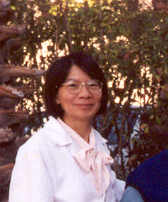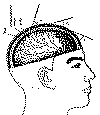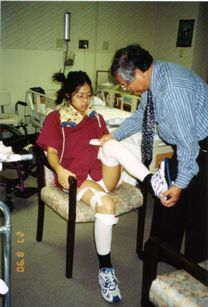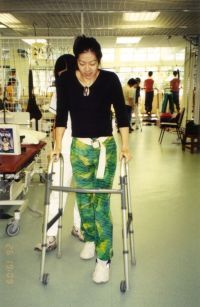

Scalp acupuncture is a specialized form of
acupuncture that has
helped many people with spinal cord injury (SCI) and dysfunction (see
introductory article).
Dr. Ming Qing Zhu
A leading scalp-acupuncturist is Dr. Ming Qing Zhu.
In 1964, Zhu graduated from the prestigious Shanghai University of Chinese
Medicine after studying with internationally recognized acupuncturists.
Zhu acquired experience in multiple disciplines, including internal
medicine, gynecology, pediatrics, traumatology, ophthalmology, neurology,
and anesthesiology; and a reputation as a preeminent Chinese physician,
especially in classical acupuncture.
After becoming dissatisfied with the limited results
obtained from traditional body acupuncture on stroke patients, Zhu
developed his scalp-acupuncture system. Since then, he has treated
thousands of stroke patients with remarkable results. Building upon these
experiences, he applied his techniques to other neurological disorders,
including SCI.
Zhuís Scalp Acupuncture (ZSA)
With ZSA, very short and fine needles are inserted
obliquely into the scalpís subaponeurotic layer .
Rather than using points along linear meridians, Zhu defined 19
two-dimensional areas, mapped to various body parts. There is no risk of
damaging brain tissue or bleeding. Manipulation is characterized by
forceful, small-amplitude needle lifting and thrusting.
.
Rather than using points along linear meridians, Zhu defined 19
two-dimensional areas, mapped to various body parts. There is no risk of
damaging brain tissue or bleeding. Manipulation is characterized by
forceful, small-amplitude needle lifting and thrusting.
An essential ZSA element is Daoyin, physical and
mental activities simultaneously carried out to direct the qi energy to
affected body areas. Daoyin activities include chest and abdominal
breathing, mental relaxation, massage, joint movements, pushing, pulling,
rolling, standing, etc. Daoyin activities are customized to individual
patient needs at the time of the treatment.
Critical Treatment Factors
All ZSA-treated SCI cases have shown marked
improvement. Effectiveness is correlated with three factors:
1) Time: The best therapeutic window is within
three months of injury. Immediately after injury, the spinal cord goes
through a shock period in which a cascade of events occur, including
bleeding or ischemia, edema, and spontaneous lysis. The damage will
gradually spread up and down the cord. Early intervention of ZSA (even day
one) helps to control bleeding and edema, shorten the spinal shock period,
and, consequently, minimize neurological damage.
If ZSA is initiated after
three months, functional recovery accrues more slowly and at a lesser
magnitude. It requires many times the effort to produce a fraction
of the same result as in the first month.
2) Daoyin: A vigorous, persistent,
six-to-eight hour/day exercise regimen is recommended, including passive
and active movements, breathing, and relaxation. Even when active motion
is not visible, the patientís intention or mental visualization is
crucial. There is nothing mystical about using the mind. Basically, the
brain initiates nerve signals to travel down the spinal cord, making
attempts to find new neuronal pathways through the injury site.
Once a visible movement is detected, the patient is
asked to repeat the same pattern over and over to establish nervous-system
memory. Our neural circuits turn off when they are not used, and,
therefore, must be re-learned. By repetition, muscle strength increases
and atrophy reverses.
Zhu encourages patients to use a standing frame early
on, believing that standing has many benefits, including keeping the spine
straight, preventing scoliosis, pressure sores, and bone loss; and
improving pulmonary and cardiac functions.
3) Scalp acupuncture: Many patients are
discouraged by the slow progress they make following standard
rehabilitation programs. The addition of ZSA to such programs accelerates
progress. Zhu expresses this recovery process through an analogy:
ďpatients with SCI are like people trapped inside a dark room. Those who
stay motionless will remain in the room forever. Those who exercise are
probing for an exit, but the door is closed. Scalp acupuncture acts like a
key. It opens the door and allows light to shine through. However, the
person still needs to move towards the door, and lift his legs over the
threshold in order to step out into the sun. Otherwise, he is still
confined in the room no matter how wide the door is opened.Ē
Scalp acupuncture has advantages over traditional
body acupuncture. First, it is much more effective in treating
neurological conditions. Second, scalp needles do not interfere with
bodily movements, whereas body needles must be withdrawn to avoid bending
or breaking. Overall, ZSA is not a mechanical procedure that can be
quickly learned; results depend heavily on the practitionerís skill level
acquired from much training and practice.
Other ZSA Benefits
In addition to functional recovery, other benefits
accrue from ZSA, including:
Relieving pain: ZSA is especially effective
in relieving SCI-associated pain, without the adverse side effects of
pharmaceuticals.
Reducing infections: ZSA and herbal medicine
can help control SCI-associated urinary-tract and other infections.
Promoting bladder & bowel control: Zhu
believes that restored bladder and bowel control is a realistic outcome
after ZSA, even for patients with clinically classified complete injuries.
Again, earlier training enhances recovery.
Managing spasticity: Zhu views spasticity as
part of a normal recovery process that can increase muscle tone. However,
if spasms become excessive, he can use ZSA and herbal medicine to control
them, again avoiding adverse drug side effects.
Managing autonomic dysreflexia: Acupuncture
has a bi-directional regulatory action on our system. For example, the
same needle at a single acupuncture point can either increase or decrease
blood pressure. It automatically adjusts to the bodyís need to restore
homeostasis.
Maintaining better overall health: Our
patients with SCI believe that they enjoy better health; have more energy,
motivation, and positive outlook; stronger immunity; and less muscle
atrophy.
Perseverance
Zhu emphasizes hard work; patients know it means
eight hours of serious work daily seven days a week. There is no short or
easy way.
What defeats people is the lack of perseverance and
long-term support. After the initial depression, most patients come to
terms with their situation and live as their doctors have indicated. A
small percentage are determined to fight the odds, but even these few may
not be able to put up with the demands of the therapy, mundane routines,
emotional cycles, and financial drain. As time goes by, they slow down on
their rehabilitation efforts, or allow themselves to be distracted by
other life activities.
SCI Cases
The following represent several example cases of
individuals treated with ZSA (pseudonyms are used):
Tom, 21, sustained T-11-compression and T-12-
burst fractures in June 2003. His MRI indicated a complete spinal-cord
transection and severe spondylolisthesis. Classified as an ASIA-A injury
(i.e., complete injury), Tom had neither motor or sensory function below
the umbilicus nor bowel-and-bladder control.
Seven months after initiating ZSA, herbal medicine,
and a vigorous exercise regimen, Tom started walking with the assistance
of walker and regained considerable bowel-and-bladder function. Defying
all medical expectations, he progressed from ASIA A to C (partial motor
and sensory recovery) in less than a year.
Nancy, 23, sustained a C5-7 incomplete injury
due to an April 2000 auto accident. Recovering in a Vancouver hospital,
she solicited the Zhuís assistance. A few weeks after injury, Zhu started
treating her at bedside from morning to evening.
Daily
 treatment
typically began with both scalp and body acupuncture. The body needles
were removed after one hour, but the scalp needles were left in for more
than 24 hours. The bulk of the days consisted of almost non-stop
exercises, from passive to active, the chest to the feet, the internal
organs to external limbs, and lying to sitting positions. A little over a
month after injury, she attempted to stand.
treatment
typically began with both scalp and body acupuncture. The body needles
were removed after one hour, but the scalp needles were left in for more
than 24 hours. The bulk of the days consisted of almost non-stop
exercises, from passive to active, the chest to the feet, the internal
organs to external limbs, and lying to sitting positions. A little over a
month after injury, she attempted to stand.

As Nancy recovered further, Zhu continued treatments,
his main goals being to alleviate pain and soreness, increase stamina,
correct posture and gait, and initiate new movements. Every week saw a
small recovery breakthrough, which cumulatively resulted in Nancy starting
to walk with a walker by November.
Eight days after sustaining a C4ĖC6 SCI after a
surfing accident, Jim started ZSA treatment. After 18 daily
treatments while still in traction, Jim initiated some arm and toe
movements, as well as torso muscle contractions. Unfortunately, he had an
untimely fusion operation after which he became paralyzed again. It took
more than four weeks for his upper extremities to get back to where they
were before the surgery. The lower extremities lost all motor functions.
Need for Cooperation &
Conclusion
Many state-of-the-art SCI research facilities believe
that the nervous system is capable of considerable regeneration after
injury. Many receive considerable grant funding for SCI animal research.
Their research findings are highly regarded, in spite of their uncertain
application to humans. Nevertheless, the merit of their approaches is
never questioned, yet scalp acupuncture is routinely met with skepticism.
Even when scalp-acupuncture results are clearly
evident, they are denied by the biomedical establishment. For example, a
patient with an incomplete C-6 injury came for treatment six months after
injury. He could only move his left lower extremity. During the first
acupuncture treatment, everybody in the room witnessed his right leg
started to move and his hand grip increased by 2.5 kg. On his second
visit, he told us that he defecated on his own volition the night after
the first treatment. Since then he did not need digital stimulation.
Surprisingly though, when he returned for his third
visit, excitement had faded from his face. His neurologist told him that
those functions wouldíve recovered spontaneously anyway and had nothing to
do with the acupuncture. Soon afterwards the patient stopped coming for
treatments. We were told many months later that his condition remained at
the same level. Was it a coincidence that the functions came back during
and right after our treatment? Why did it not continue to improve on its
own after the treatments stopped? How can we explain the many coincidences
that we observe in our clinic? Although it is true that incomplete SCI may
recover spontaneously, is it not also apparent that scalp acupuncture
helps to speed up the recovery?
SCI is so complex that no single approach alone can
fix it. It requires multi-disciplinary modalities working synergistically.
We hope that Zhuís Scalp Acupuncture can be accepted and valued as one of
them. We strongly believe that in conjunction with other therapies,
especially in the early stage of SCI, Zhuís Scalp Acupuncture can
significantly speed up and promote functional recovery.
For further
information: see
www.scalpacupuncture.org or
call 408-885-1288.
TOP